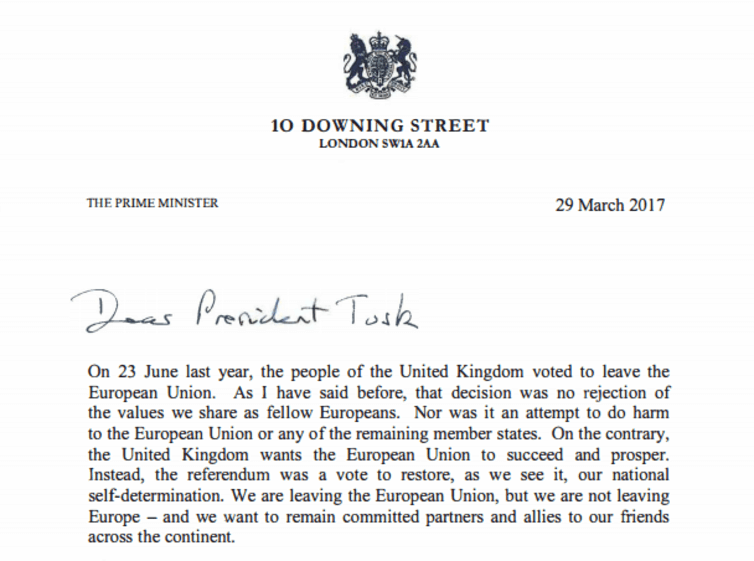A linguist's guide to the Theresa May Article 50 letter
With the delivery of Theresa May’s letter to Donald Tusk, the European Council president, the UK gave official notification of its intention to leave the EU. The letter not only signalled the legal start of the Brexit process, but also gave the British prime minister the chance to frame the tone of the negotiations. The letter was her opportunity to communicate a vision for how she would like to see Brexit talks proceed.
The language used to discuss Brexit over the past nine months has often been rancorous and divisive, and has generated a whole new vocabulary of Brexiteers and Remoaners. The rhetoric in the letter is far more measured, though not without a certain steeliness – and the occasional veiled threat.
“Continuity” and “certainty” are two recurring themes in the letter. Both words are restated several times. In this respect, one of the letter’s principal aims seems to be reassurance, especially around economic issues. What’s being triggered, the letter would like to suggest, is an orderly and controlled process, and certainly not an uncoordinated scramble.
Setting the tone
The tone is polite but forceful, indicating that May intends to engage fully with the negotiations while also underlining her authority as the spokesperson for the citizens of the UK. The reference to restoring “national self-determination” in the opening paragraph reads like a direct, if rather formal, echo of the “take back control” refrain which was so much a part of the referendum debate.
A letter of this sort is always addressed to multiple audiences at the same time. Although ostensibly written to Tusk, the prime minister is aware that it will be read – and read into – by many other interested parties. Part of her job is to find a balance that speaks to all of them.
At the same time, the choice of words to address European citizens is purposefully inclusive. May talks of “fellow Europeans”, “friends across the continent”, and “our” continent. But when the letter talks of the importance of the process working to ensure the rights and interests of “all our citizens”, it implicitly acknowledges the divisions that will likely come into play for EU nationals living in the UK, and UK nationals living on the continent.
Divided Kingdom
The letter also indirectly references the troubled relationship between the nations of the UK. The prime minister makes a point of stressing that England, Scotland, Wales and Northern Ireland will be negotiating as “one United Kingdom” – which also serves to remind anyone reading the letter that there is considerable disagreement on the UK’s collective negotiating position, given that the devolved nations have different priorities.
May does however offer the possibility of further consolations for Scotland, Wales and Northern Ireland by implying that Brexit could lead to greater devolution:
When it comes to the return of powers back to the United Kingdom, we will consult fully on which powers should reside in Westminster and which should be devolved to Scotland, Wales and Northern Ireland. But it is the expectation of the Government that the outcome of this process will be a significant increase in the decision-making power of each devolved administration.

Again, the aim here seems to be to try and placate and reassure as many people at the same time as possible. And even as May is addressing an audience at home, she’s also talking to a global one.
Another phrase repeated throughout the letter is the “special partnership”. May apparently envisages between the UK and the EU – clearly echoing the “special relationship” between the UK and the US, while at the same time being noticeably different. Perhaps May is trying to signal that the UK does in fact have allies beyond the EU, and that it could perhaps act as a bridge across the Atlantic.
The veiled threat
The statement May delivered to the House of Commons while this letter was being delivered was an interesting contrast. Throughout that speech she repeatedly used the word “together” to address the audience, trying to portray the process as being inclusive for all those living in the UK. As a BBC’s political journalist tweeted, this was a “Conciliatory tone towards EU. Theresa the Dealmaker”.
But while the language of the letter certainly strikes a conciliatory tone at times, it still has a forceful edge. Amid all the talk of stability, continuity and joint values are several warnings about security. May reminds Tusk that “Europe’s security is more fragile today than at any time since the end of the Cold War” and stresses her desire to make sure Europe remains safe.
Several of these references to security concerns are made alongside discussion of the trade deal negotiations ahead. In repeatedly pairing the UK’s area of strength (security) with its area of potential weakness (the trade deal), the underlying message can easily be taken as a veiled threat: were the EU to lose the support of the UK in security, it would be detrimental to everyone’s future safety – so let’s play nicely on the trade deal.
This article was originally published on The Conversation. Read the original article.

Philip Seargeant does not work for, consult, own shares in or receive funding from any company or organisation that would benefit from this article, and has disclosed no relevant affiliations beyond the academic appointment above.

 Yahoo News
Yahoo News 
